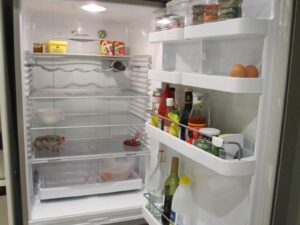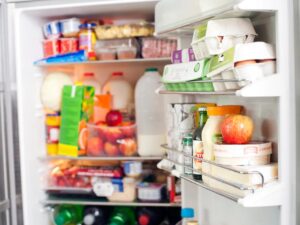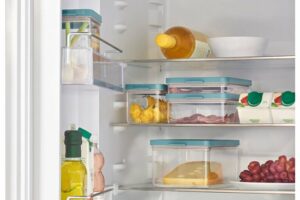10 Helpful Tips to Organise your Fridge
If you have a busy household full of fussy eaters, dietary restrictions, or family members always on the go, chances are your fridge could do with some TLC. In even the cleanest of homes, there can be harmful germs and bacteria lurking in the darkest corners of your fridge drawers and shelves, and it’s key to keep these away so you and your family can stay healthy and happy! We’ve got 10 helpful tips to organise your fridge and stop any nasty bacteria buildup – read on to find out!
Why is a Clean Fridge Important?
Keeping your fridge clean may be a chore that falls to the bottom of your to-do list every week, but it is actually really important. Every time you touch the foods in your fridge or unpack your shopping, new cultures and bacteria are introduced into your fridge, so there are loads of opportunities for germs to enter.
A survey carried out by Which found that seven out of ten fridges contain harmful bacteria. Harmful bacteria like Listeria, which can cause serious illness, can thrive in unclean fridges and freezers, so keeping your fridge clean is really important for your and your family’s wellbeing.
Get the Timing Right
To ensure you don’t have to leave loads of perishable foods out on your worktop while you work, make sure you clean your fridge just before a big food shop. This way, your fridge will be at its emptiest and you can do a deep clean with relative ease.

Remove Everything
Obviously, to clean your fridge really well, you need to clear out all its contents (Yes, that includes all those sauce bottles in the door!). For anything perishable, particularly dairy or meat products, it’s good to have some cold bags to hand so you can keep them at safe temperatures while you clean.
Take out all Shelves and Drawers
Since this is a deep clean, a swipe of an antibacterial wipe is not going to cut it! You want to ensure that all the cracks and crevices of your fridge get cleaned thoroughly. Make sure you remove all the shelves and drawers that you can and leave them to soak in hot soapy water while you work on the rest of the fridge or reorganise your food.
Keep it Food-Friendly
If you are worried about using strong chemicals near your food items, don’t worry – it’s still possible to banish germs from your fridge with natural cleaning solutions. A simple one-part vinegar to three-part water solution will disinfect surfaces while also getting rid of any mould or mildew that is hanging around the recesses of your fridge.
If you don’t have any vinegar to hand, good old-fashioned hot soapy water will do the trick too. It’s food-safe, germ-killing, and should get rid of any greasy residue in your fridge. Whatever you use, just ensure you get into every corner. For particularly tricky cracks, cotton buds or old toothbrushes can be really useful!

Get Sorting
After all this cleaning, it’s time to focus on what is going back in the fridge. Take this time to really thoroughly check all your food items and their expiry dates. Give everything a smell, make sure it’s all safe to eat, then organise it into categories. It doesn’t need to be too complicated – just group things together, like raw meats, dairy, sauces, etc.
Protect your Fridge
To avoid having to clean up any future messy spills or leaks, it’s a great idea to line your drawers or shelves with liners that are cheap and easy to get from Amazon. If you don’t want to splash out on these, a similar effect can be achieved with old newspaper or carefully placed clingfilm, although these might not last as long as the liners.

Chill Out
When your shelves and drawers are all thoroughly cleaned and put back in place, close your fridge and allow it to get cold again. It is tempting to whack all your food back in once it’s clean, but it isn’t safe to put your food back into a warm fridge! Keep your perishable goods in cold bags while your fridge reaches its correct temperature, which can take several hours.
Top Tip: the recommended temperature for a fridge is between 3 and 5 degrees celsius.
Do your Research
Before you chuck everything back into the fridge, make sure you know your food hygiene rules. It’s recommended that uncooked meats and fish go on the lowest possible shelf, to ensure any liquids do not drip onto ready-to-eat food and contaminate it.
Similarly, it’s recommended that you keep dairy and cooked meats near the top of the fridge. Any fruits and vegetables should be in the fridge drawers to keep them fresh; if you’re keen to keep your fridge extra-clean, give your fruit and veg a rinse when you get back from the shops. This way, it’s already clean when you come to use it, and it’s keeping your fridge clean too.

Deodorise
To keep your fridge smelling fresh long after you have given it a thorough clean, you can leave a small cup of bicarbonate of soda on a shelf to absorb any bad odours. This can work as a deodoriser for up to three months, so just make sure you replace it once it has done its job!
Teach Everyone about Food Hygiene
It’s all well and good if you know how to organise your fridge, but make sure everyone else in your family knows how to as well! A handy refrigerator rules poster stuck to the fridge door will remind everyone of where everything goes, plus it’s great to get your kids practicing good food hygiene from a young age!